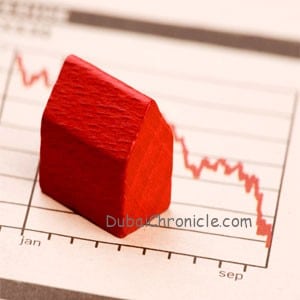
Dubai property prices have witnessed a slight correction in the third quarter of 2014. This is not a new fact to investors, neither to real estate industry insiders. According to various estimates, Jumierah Park saw a correction of 3.5%, Greens 3.1%, Springs/Meadows fell by 3.4%, Arabian Ranches fell by 3.3% and JVC by 2.6%. In contrast, the most active area – Dubai Marina – remained stable while JBR actually rose by 3.2%. Asteco’s latest quarterly report also noted la slight correction of a 1% in apartments and a 4% in villa sales prices.
At present, most developers are struggling to off-load their inventory of off-plan stock. The new projects are too many, while investors’ sentiment is suppressed by global economic growth slowdown and geopolitical risks. Number of investors willing to buy off-plan property for short-term investment has dramatically fallen in Dubai. One of the main reasons is the lower growth prospects as compared to the past. Investors are also shying away from investing in ready stock, due to falling yield rates and high cost of services related to real estate transactions and maintenance.
Since April, there has been a correction going on, but it softened after the Eid Al Adha holiday. This type of a property prices correction looks more like a soft landing, but not as a crash. It might be viewed also as a long-term positive for the stabilizing of Dubai’s real estate market.
With residential rents still quite high, end-users are increasingly looking to get out of the rent trap and instead to become home owners. The fact that interest rates are still quite low makes owning a property much more profitable than renting. The trend of end-users getting on to property ladder is increasing by the day. Hence, the recent reports by Dubai Land Department about increase transactions values may act as a proof supporting that trend. On the other hand, the availability of ready residential stock is helping this trend. The variety of residential options suits different customer segments.
Dubai land department has reached 4.1 Billion in transactions this week. pic.twitter.com/nZuipJL80z
— دائرة الأراضي – دبي (@Land_Department) November 21, 2014
In this new real estate market scenario, interest rates might determine the market direction. US Federal Reserve stopped the bond-buying programme popularly known as QE3, QE standing for quantitative easing. To put it simply, US Fed was pouring money into the markets to increase the money supply with the objective of stumulating the markets. This kept the interest rates low for a long time and increased the amount of money available to buy assets. However rates are expected to go up some time in future. General consensus is that the rate cycle will start reversing itself in second quarter of 2015. However, back in the second quarter of 2013, economists have had similar expectations.
In a survey conducted of top seventeen economists advising US fed the rates could go up as high as 3.25% by end of 2015 and settle at 4.25% in 2016. Since Dirham is pegged to Dollar, UAE’s housing market will be directly effected. Furthermore, mortgage rates may increase to between 5% to 9%.
The existing scenario is that rents are high and interest rates are low, and this situation benefits end-users as they can obtain mortgages with low interest rates. Mortgage rates are expected to stay low in the short term, at least until next September. This could help the house prices remain stable in the foreseeable future.



































